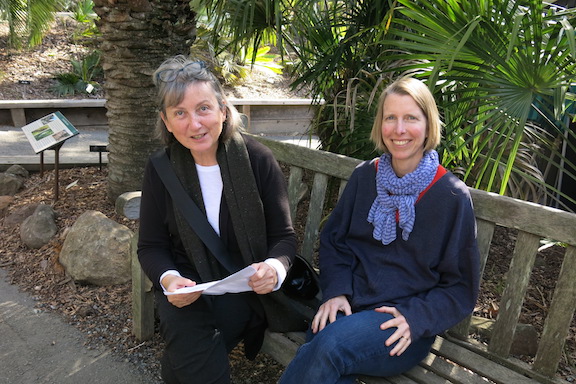
Kingdom, phylum, class, order, family, genera, species.
Since the 18th century scientists have used Linnaeus’ nested hierarchy to categorize and classify nature. Based on shared physical characteristics, not simply on differences, taxonomy allows us to look at animals and plants with a closeness we might not otherwise consider.
Counting petals, examining tissues, noting whether leaves are round, oval or frilly. Waiting to see whether the plants return the following year, setting new growth, or disappear into the earth as seeds. All these physical characteristics are the basis of taxonomy and the basis of the sciences that allow us to cultivate and live on our planet. How, though, would we categorize and classify plants if we were poets rather than scientists? Artists rather than horticulturalists? Laymen rather than specialists?
These are the questions that Bay Area–based poets Denise Newman and Hazel White have posed and that, with the Botanical Gardens at UC Berkeley, have set out to answer.
Funded by a grant from the Creative Work Fund to create a poetry project in the garden, the poets have set up a studio in the lovely botanical gardens located in Strawberry Canyon. From there they record the progress of the garden through the year, interview the gardeners and workers at the site and ask questions of visitors. They estimate that eventually they will have a 1,000-page index of observations of plants and biotic relations at the site, taken from the extremely delicate and evanescent position of the poet.
No matter how you dissect it, this is one hefty job.
The UC Berkeley Botanical Garden has over 13,000 different kinds of plants from around the world. The plants are cultivated in naturalistic landscapes over its 34 acres, and among the regions are a Chinese Medicinal Herb Garden, a Garden of Old Roses, a collection of New World Desert plants, a Cycad and Palm Garden and special collections of orchids, ferns, carnivorous and tropical plant housed in greenhouses. California native plants occupy approximately one-third of the botanical gardens and the over 2,900 accessions are grouped by plant communities. Established in 1890, this non-profit research garden and museum for the University of California at Berkeley is world renowned and includes many rare and endangered plants.
So how does one make a poet’s index of it all? Besides making their own observations, Newman and White are asking visitors to contribute. And they do this by posing questions, which they ask the visiting public to answer and contribute to.
Here is a question: When were you given the gift of a plant?
Not only does the question establish a very personal bridge between the asker and the answerer, but it suggests a system of evaluation that underlines the value of plants as emotional forms of communication. For no one gives a true gift unless they feel it is valuable, pleasing and emotionally dear.
Every Friday from 11-2 you can find them near the garden’s conference center. Visitors are encouraged to stop by and help them in their poetic reordering of the botanical collection.
The project, called “Biotic Portal at Strawberry Creek” and listed in the garden’s Calendar as “The Poets Are Here”, will also involve overlapping sequences of interactive events at the poets’ studio in the Garden, on social media, and along the Garden creek.
On Sunday, April 10, from 4 to 7 pm Newman and White will launch their project by presenting an overview of their project with videos, including a preview of the annotated index of biotic relations that will be produced in collaboration with the Garden’s staff and the public. The poets will also lead walks on Sunday, April 17, Wednesday, May 25 and Friday, June 22. Events are free, but require registration.
The launch takes place in the Julia Morgan Hall, which was recently moved from the university campus to the Gardens. Built in 1911, the Senior Women’s Hall is a monument to the status of women at UC Berkeley, and was their first social center. Recognized as a Berkeley Landmark and on the National Historical Registry, the newly renovated building received a 2015 ‘Preservation Award’ from the Berkeley Architectural Heritage Association (BAHA).
Take a walk on the wild side! Visit the beautiful UC Berkeley Botanical Gardens and participate in some poetic data collection along the creek.
– Jaime Robles
To register for the Biotic Portal at Strawberry Creek launch, visit https://41780.blackbaudhosting.com/41780/Biotic-Portal-Launch. You can follow the progress of the project on Facebook at facebook.com/bioticportalatstrawberrycreek.
Photo: Hazel White (l) and Denise Newman at the UC Berkeley Botanical Gardens. Photo by Jaime Robles.
